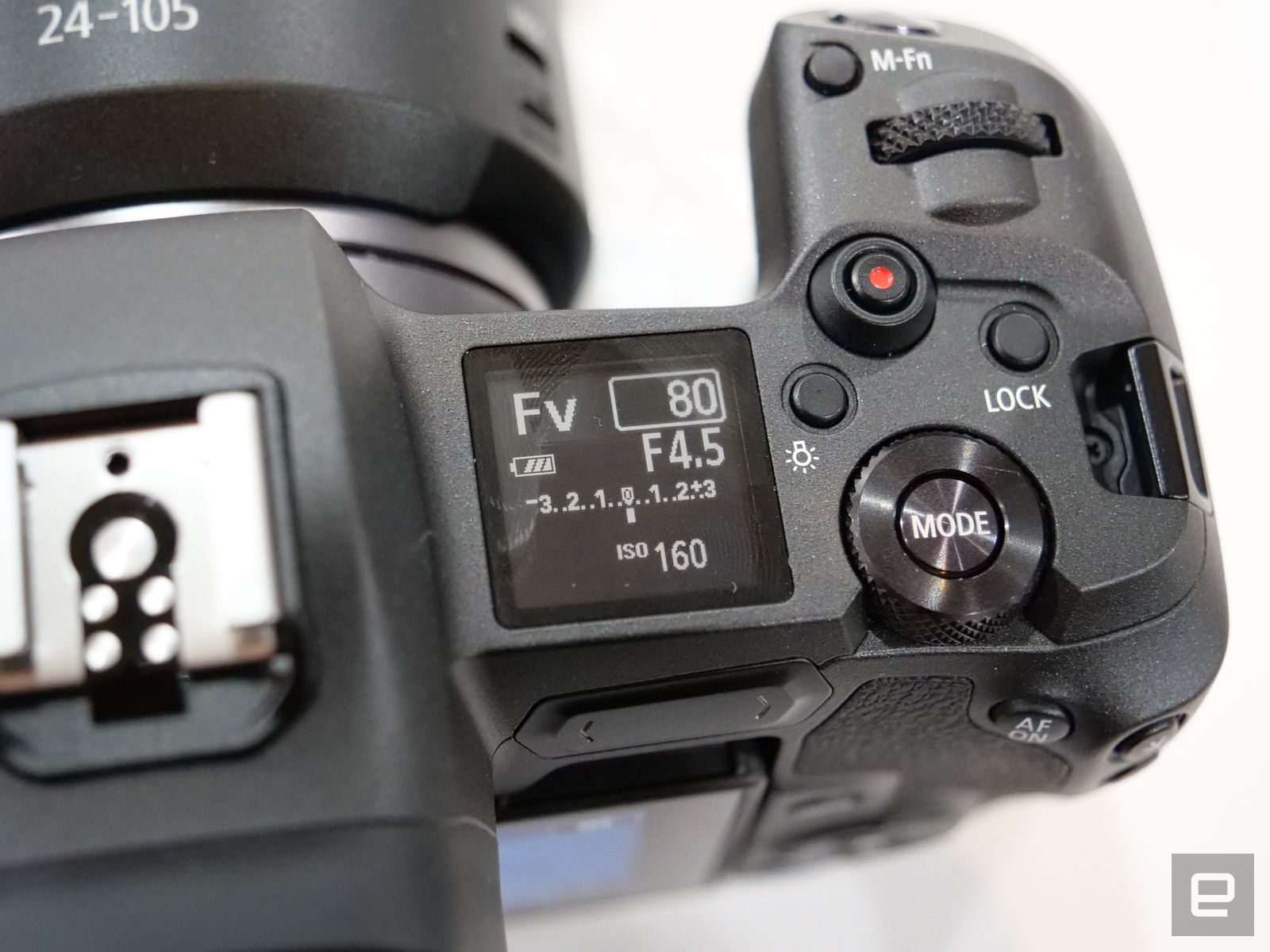[ad_1]
While Nikon’s Z6 and Z7 are its first ever interchangeable-lens cameras with in-body stabilization (IBS), the EOS R is unfortunately lacking that feature. While you’ll get anti-shake features via the new RF lenses and existing EF glass, the lack of IBS is black mark for the EOS R.
Body, EVF and rear display
The EVF is a 3.69 million dot OLED model with 100 percent coverage and a 0.76x magnification. Rather than a joystick, you use the right-hand part of the touchscreen to select focus when using the EVF. Canon also unveiled a MacBook-like “multifunction touch bar” that you can program for different settings like ISO, shutter speed, autofocus and more. Vloggers and selfie-takers will be glad to know that the 2.1-million dot touch panel has a rotating, flippable display. Nikon’s Z-cameras, by contrast, just have tilting touch displays.
The EOS R has a dust- and drip-proof magnesium body that weighs 660 grams (1.5 pounds) with a battery, about the same as the Z7 and Sony’s A7 III. Much like with Nikon’s Z models, it has a meatier handgrip that should make it more desirable for professionals. It uses the same LP-E6N batteries as the 5D Mark IV, which will yield a better battery life than Nikon’s Z6/Z7. If you need even more, a battery grip (the BG-E22) is available.

Also like the Z6/Z7 and Fujifilm’s X-H1, there’s a liquid crystal display on top that shows aperture, shutter speed, ISO and other essential settings. Unfortunately, there’s only a single SD card slot, but at least it supports high speed SDXC UHS-II, rather than Nikon’s more esoteric XQD and CFexpress Type B formats.
Video
In my opinion, Nikon overachieved with video, offering 4K with a full sensor readout on the Z6 and 10-bit HDMI output on both the Z6 and Z7. Unfortunately, Canon’s EOS R doesn’t measure up, despite the company’s reputation for video excellence. It shoots 4K at 30 fps, but as with the 5D Mark IV, there’s a considerable 1.7 times crop factor. That makes it less useful for vloggers, as you’ll need a wider-than-normal lens to shoot yourself (and others) from up close. You also effectively lose the light-gathering and shallow depth-of-field benefits of a full-frame sensor.
It also shoots 1080p video at just 60 fps, compared to 120 for the Z6, Z7 and Sony’s A7 III. On the plus side, the EOS R does have 4:2:2 10-bit video output externally via the HDMI port (internally, it’s 8-bit). That will give serious video shooters more latitude for color correction. It also has 3.5mm microphone and headphone jacks.
Other features
Like the 5D Mark IV, the EOS R has Dual Pixel RAW, a system that takes two 30.3-megapixel images nearly simultaneously. That changes the way the bokeh looks in out-of-focus regions, and boosts the dynamic range a bit. Connectivity-wise, you get WiFi, Bluetooth and NFC, along with USB-C and HDMI. The camera can be charged with the latter while shooting, but you must use Canon’s included USB Power Adapter PD-E1.
First impressions and wrap-up
I had a half-hour or so to play with the EOS R with the 50mm f/1.2, 24-105 f/4, and a model with the adapter and an EF 24-70mm lens (stay tuned for an extensive hands-on soon). So far, the autofocus seems very accurate with moving subjects, and the eye-tracking works well provided subjects are close enough.
The EOS R is nice and light, though the 50mm f/1.2 is a pretty heavy lens, and I’d expect the 28-70 f/2 lens will not be a lightweight, either. Not that I’m complaining, though — those are two fantastic lenses that will be available shortly after the EOS R launches. They let you shoot in low light without resorting to crazy ISOs, though the autofocus occasionally struggles with focus at f/1.2.
I have to say that the EOS R seems incredibly solid, more so than Sony’s A7 III and maybe even a bit more than the new Nikon Z models. The grip is also nice and fat, something that Canon pro DSLR photographers will likely appreciate. The $2,299 price is more than both the Nikon Z6 and Sony’s A7 III (both cost $2,000), and might be a hard sell given the sensor cropping for 4K video.
I got to see and photograph Canon’s EOS R, and was able to handle it briefly but not take photos. I can say that I like how it looks and feels, and I’ll get a chance over the next few days to test it out in various shooting circumstances. The EOS R full-frame mirrorless camera will be available in October, 2018 for $2,299, or $3,399 with the RF 24-105 F4 L IS lens. The EF-M 32mm f/1.4 STM will cost $500 and arrive in September, the RF 50mm f/1.2 L will cost $2,299 when it arrives in October 2018, the RF 28-70mm f/2 lens will cost $2,999 and come to stores by December 2018. The RF24-105 F/4 L IS USM lens will cost $1,099 and hit stores in December, 2018.
On occasion Engadget will accept travel and lodging from manufacturers to test products not yet available locally for review. In this case, Canon had a single North American and European launch in Maui. We do this to make sure our readers have the latest information and expertise about new products. This is often the practice for significant new camera launches. This in no way colors our editorial coverage of the cameras or of the manufacturers themselves.
Source link
 Tech News code
Tech News code


